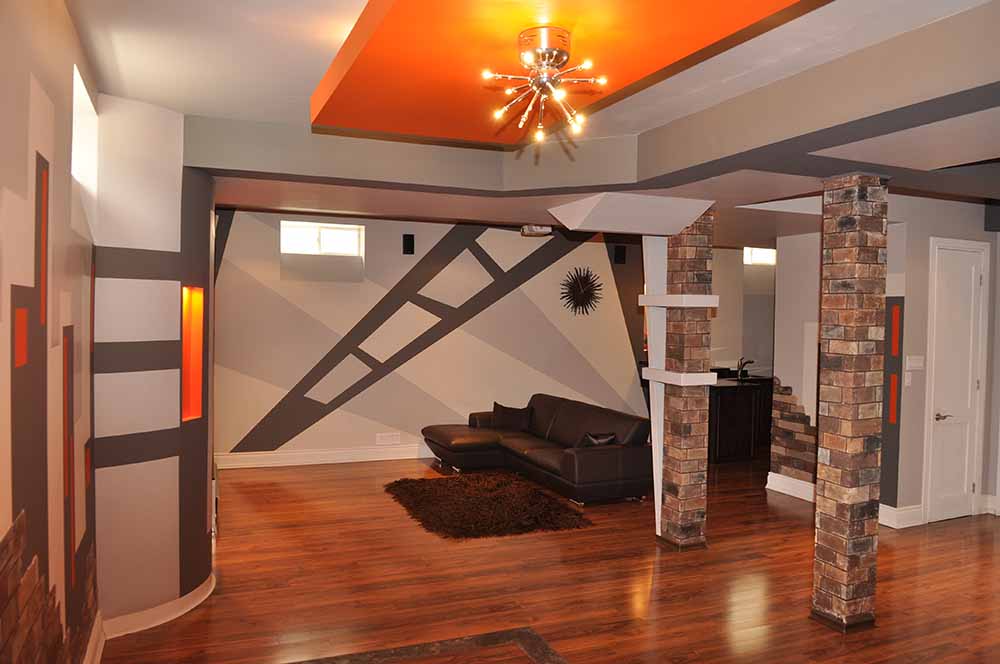
Canadians tend to either love or loathe their basements. There’s a good reason for this: a well-finished and tastefully remodelled basement can add living space, energy-efficiency, and value to your home. An unfinished or outdated basement, on the other hand, is more often than not a dark, musty place to be avoided at all costs unless you’re doing laundry or pulling the holiday decorations out of storage. For those in the latter category, turning your basement from a damp and odorous storage space into a useful and versatile living area may not be as complicated or expensive as you think. Here are a few things you can do to make your basement a place you’ll actually want to spend time in.
Dry off Floor it Overhead savings Wall upgrade Finishing touches
Dry off
Before you get to the fun part, you need to make sure your basement is as dry and waterproof as possible. Because its walls are below ground, a basement is prone to dampness and flooding, which can lead to structural decay and mold. Have a reputable basement repair company come take a look at your space and make any necessary fixes before you start on your remodel. This will help keep moisture at bay and make the space all the more cozy once it’s finished. While it might be tempting to skip this step, the last thing you want is to have all of your remodelling work ruined by a flood later on.
Floor it
Dingy old carpets or scuffed concrete are usually the first things you’d notice in a basement in need of a remodel, but fortunately these things are fairly easy to remedy. If you like the industrial vibe of a concrete floor, consider sealing or painting the existing surface to make it look brand new, then adding runners, mats and throw rugs to brighten it up. If you’re after a warmer look and feel, explore your options for vinyl, carpet and laminate flooring, all of which can be installed on a budget. If you go this route, consider adding a layer of insulating subfloor panels first. In addition to being warmer on your feet, this can also help to make your home more energy-efficient overall. It’s also worth considering who will be using the space and choosing your materials accordingly. If you have small children and pets, for example, a good quality laminate may look better for longer than carpet.
Overhead savings
A ceiling of wooden support beams and electrical conduits is a hallmark of many an unfinished basement, and covering this up with drywall or installing a drop ceiling can be costly. Instead, many homeowners opt to leave the ceiling exposed and dress it up with a coat of paint. While white paint can help to brighten the space (and most basements need all the help they can get in this department) painting the exposed ceiling black or dark grey will help to hide the wiring and ductwork. If you choose to DIY the paint job, consider buying or renting an airless paint sprayer which will make it much easier to get into all of the nooks and crannies. It’s also advisable to do this before you install your new flooring so you don’t have to worry about drips and spills later on.
Wall upgrade
If you are going to spend a bit extra on one element of the room, finishing concrete or cinderblock walls with drywall is a good one to consider. Drywalling does wonders to improve the look of a space and if you add a layer of insulation underneath it can also help to make your home more energy efficient. While it’s certainly possible to DIY a basement drywall job, if you don’t have the time or the ambition, there’s nothing wrong with bringing in a professional for this part and saving some money by doing the painting on your own.
Finishing touches
Once the big things are taken care of, it’s time for the fun part: decorating. If you’re starting with a large room, you can opt to divide it into different activity zones (a kid’s play area, an exercise zone, a TV zone) using portable room dividers, curtains or bookshelves. Area rugs and accent light fixtures, and framed posters or prints will also help to make the space more inviting. With all of these upgrades in place, you can look forward to a space that’s warmer, brighter, and – most importantly – more inviting for you and your family.
Jeremy Freed is a freelance writer and editor based in Toronto. His writing about fashion, travel, food and design appears in Sharp, Harry and re:Porter magazines, among many others.